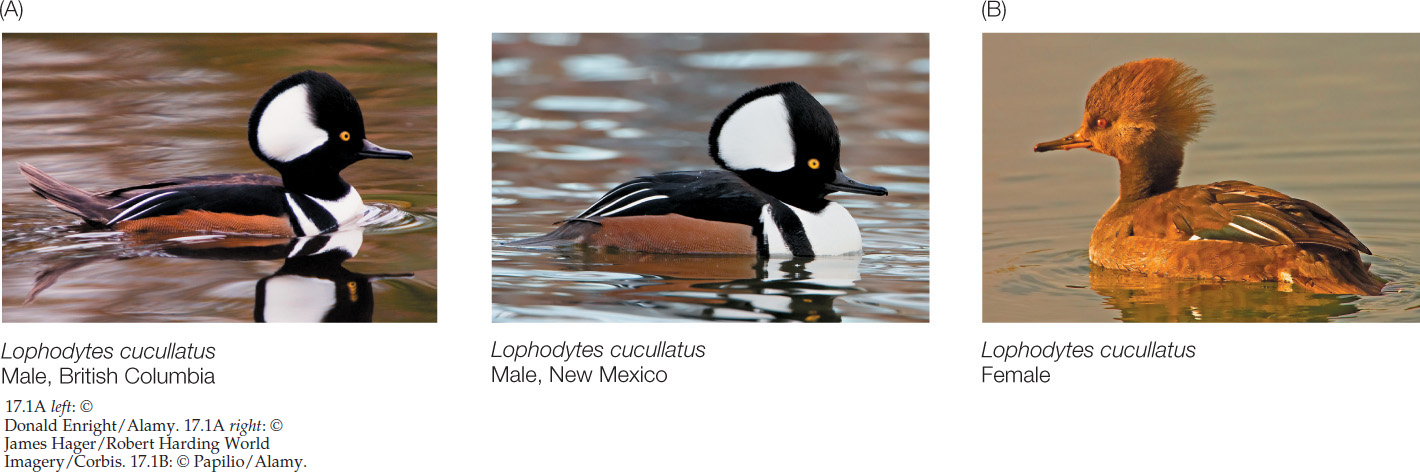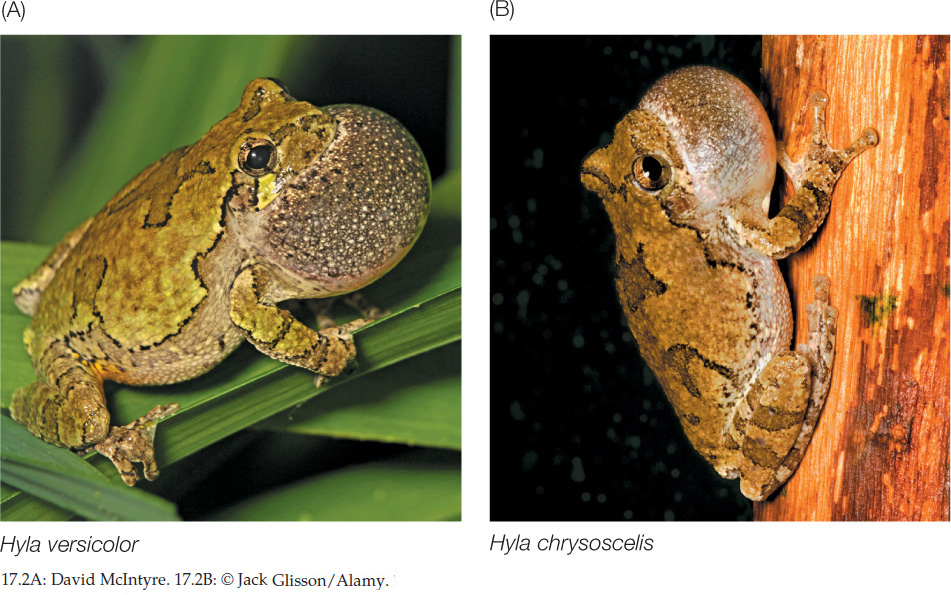CONCEPT17.1 Species Are Reproductively Isolated Lineages on the Tree of Life
Biological diversity does not vary in a smooth, incremental way. People have long recognized groups of similar organisms that mate with one another, and they have noticed that there are usually distinct morphological breaks between these groups. Groups of organisms that mate with one another are commonly called species (note that this is both the plural and singular form of the word). Species are the result of the process of speciation: the divergence of biological lineages and the emergence of reproductive isolation between lineages.
Although “species” is a useful and common term, its usage varies among biologists who are interested in different aspects of speciation. Different biologists think about species differently because they ask different questions: How can we recognize and identify species? How do new species arise? How do different species remain separate? Why do rates of speciation differ among groups of organisms? In answering these questions, biologists focus on different attributes of species, leading to several different ways of thinking about what species are and how they form. Most of the various species concepts proposed by biologists are simply different ways of approaching the question “What are species?” Let’s compare three major classes of species concepts to contrast the way that biologists think about species.
We can recognize many species by their appearance
Someone who is knowledgeable about a group of organisms, such as birds or flowering plants, can usually distinguish the different species found in a particular area simply by looking at them. Standard field guides to birds, mammals, insects, and wildflowers are possible only because many species change little in appearance over large geographic distances (FIGURE 17.1A).

More than 250 years ago, Carolus Linnaeus developed the system of binomial nomenclature by which species are named today (see Concept 16.4). Linnaeus described and named thousands of species, but because he knew nothing about genetics or the mating behavior of the organisms he was naming, he classified them on the basis of their appearance alone. In other words, Linnaeus used a morphological species concept, a construct that assumes a species comprises individuals that look alike, and that individuals that do not look alike belong to different species. Although Linnaeus did not know it, the members of most of the groups he classified as species look alike because they share many alleles of genes that code for morphological features.
Using morphology to define species has limitations. Members of the same species do not always look alike. For example, males, females, and young individuals do not always resemble one another closely (FIGURE 17.1B). Furthermore, morphology is of little use in the case of cryptic species—instances in which two or more species are morphologically indistinguishable but do not interbreed (FIGURE 17.2). Biologists therefore cannot rely on appearance alone in determining whether individual organisms are members of the same or different species. Today biologists use several additional types of information—especially behavioral and genetic data—to differentiate species.

Reproductive isolation is key
The most important factor in the long-term isolation of sexually reproducing lineages from one another is the evolution of reproductive isolation, a state in which two groups of organisms can no longer exchange genes. If individuals of group “A” mate and reproduce only with one another, group “A” constitutes a distinct species within which genes recombine. In other words, group “A” is an independent evolutionary lineage—a separate branch on the tree of life.
Evolutionary biologist Ernst Mayr recognized the importance of reproductive isolation in maintaining species, and so he proposed the biological species concept: “Species are groups of actually or potentially interbreeding natural populations which are reproductively isolated from other such groups.” The phrase “actually or potentially” is an important element of this definition. “Actually” says that the individuals live in the same area and interbreed with one another. “Potentially” says that even though the individuals do not live in the same area, and therefore do not interbreed, other information suggests that they would do so if they were able to get together. This widely used species concept does not apply to organisms that reproduce asexually, and it is limited to a single point in evolutionary time.
345
The lineage approach takes a long-term view
Evolutionary biologists often think of species as branches on the tree of life. This idea can be termed a lineage species concept. In this framework for thinking about species, one species splits into two or more daughter species, which thereafter evolve as distinct lineages. A lineage concept allows biologists to consider species over evolutionary time.
A lineage is an ancestor–descendant series of populations followed over time. Each species has a history that starts with a speciation event by which one lineage on the tree is split into two, and ends either at extinction or at another speciation event, at which time the species produces two daughter species. The process of lineage splitting may be gradual, taking thousands of generations to complete. At the other extreme, an ancestral lineage may be split in two within a few generations (as happens with polyploidy, which we’ll discuss in Concept 17.3). The gradual nature of some splitting events means that at a single point in time, the final outcome of the process may not be clear. In these cases, it may be difficult to predict whether the incipient species (lineages in an initial stage of development) will continue to diverge and become fully isolated from one another, or if they will merge again in the future.
The different species concepts are not mutually exclusive
Many named variants of these three major classes of species concepts exist. The various concepts are not entirely incompatible, however. Rather, they simply emphasize different aspects of species or speciation. The morphological species concept emphasizes the practical aspects of recognizing species, although it sometimes results in underestimation or overestimation of the actual number of species. Mayr’s biological species concept emphasizes that reproductive isolation is what allows sexual species to evolve independently of one another. Lineage species concepts embrace the idea that sexual species are maintained by reproductive isolation, but extend the concept of a species as a lineage over evolutionary time. The species-as-lineage concept is also able to accommodate species that reproduce asexually.
Virtually all species exhibit some degree of genetic recombination among individuals, even if recombination events are relatively rare. Significant reproductive isolation between species is therefore necessary for lineages to remain distinct over evolutionary time. Furthermore, reproductive isolation is responsible for the morphological distinctiveness of most species, because mutations that result in morphological changes cannot spread between reproductively isolated species. Therefore no matter which species concept we emphasize, the evolution of reproductive isolation is important for understanding the origin of species.
CHECKpointCONCEPT17.1
- Why do different biologists emphasize different attributes of species in formulating species concepts?
- What makes reproductive isolation such an important component of each of the species concepts discussed here?
- Why is the biological species concept not applicable to asexually reproducing organisms? How do biologists consider the species status of asexual organisms?
Although Charles Darwin titled his groundbreaking book On the Origin of Species, in fact it included very little about speciation as we understand it today. Darwin devoted most of his attention to demonstrating that individual species are altered over time by natural selection. The following sections discuss the many aspects of speciation that biologists have learned about since Darwin’s time.
346